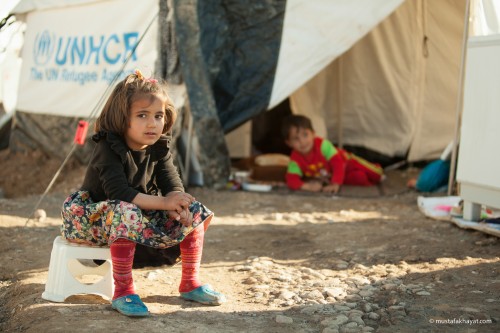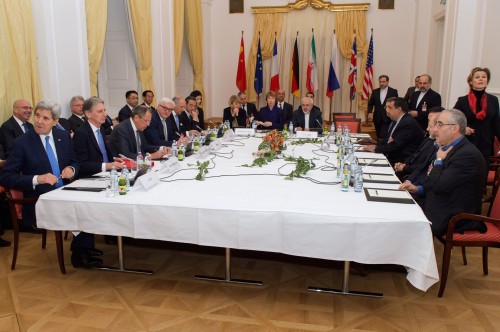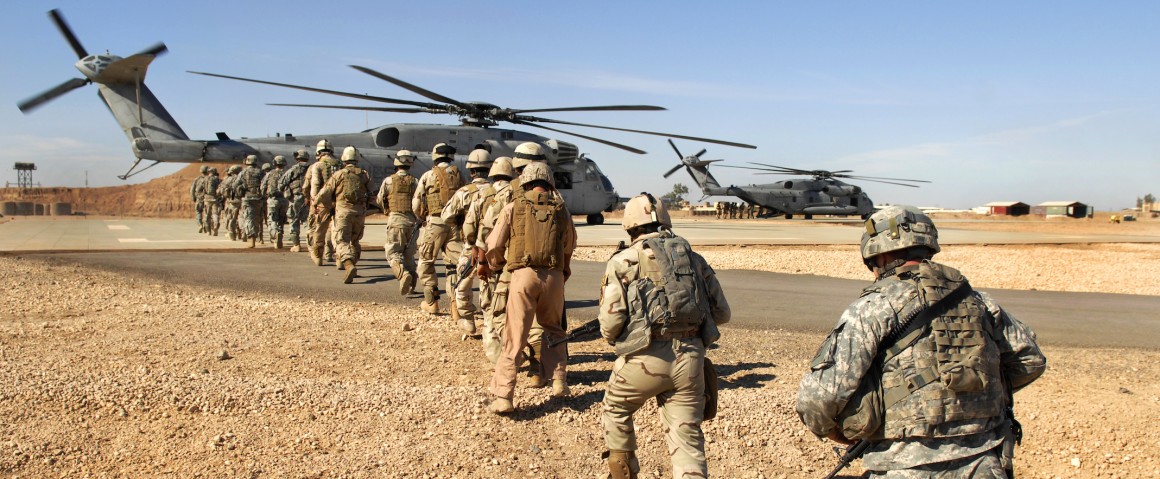“The world is literally about to blow up,” Senator Lindsay Graham proclaimed early last year. Though his comment was, at best, hyperbolic, 2014 truly was a tumultuous year for international affairs. New threats from state and non-state actors alike contributed to unrest and instability from the Middle East to Eastern Europe to the South China Sea. Overall, 2014 saw the creation of more challenges and crises, with few resolutions. As we start a new year, the world continues to face a daunting agenda.
A few of us at The Georgetown Public Policy Review look ahead to 2015 and reflect on events that impacted international affairs in the past year. In this article, we review the violence in Ukraine, the neglected Syrian refugee crisis, and the nuclear negotiations between the P5+1 and Iran. No matter the affair, one thing is clear: 2015 is already shaping up to be full of potential triumph or catastrophe.
“We can’t predict anything in the world and in life, but we do know that the unpredictable is the predictable,” former Secretary of Defense Chuck Hagel remarked in November. While far from prophesizing, we here at GPPR try to predict the unpredictable for what to expect in 2015.

Ukraine and Russia in 2015
By Andrew Shell
The past year brought political upheaval, annexations, invasions, and ongoing violence to the once peaceful former Soviet Republic of Ukraine. Tensions between Russia and the West boiled over and American relations with Russia are now at their lowest point since the Cold War. What will 2015 bring to this troubled region?
Continuing Russian Economic Woes
Sanctions from the United States, Canada, Japan, and the European Union along with a precipitous drop in oil prices have wreaked havoc on the Russian economy and stability of the ruble. Russia’s economy shrank by 0.5 percent in November—its first contraction since 2009—and analysts predict 10 percent inflation and a 4 percent contraction in 2015.
These troubles are about to get increasingly serious for Russia. In just two weeks last month, the Central Bank of Russia burned through $26 billion in cash reserves propping up the ruble, and total reserves have fallen by more than a quarter since the start of the crisis in Ukraine. While the government’s efforts did stop a freefall of the ruble, the currency has still lost about half of its value in the last year. With the price of oil plummeting, the economic situation looks grim for Russia. In Russia’s “near abroad,” Belarussian President Alexander Lukashenko has recently insisted his country’s trade with Russia should be conducted in U.S. dollars for the sake of stability. And last week, rating agencies again downgraded Russia’s credit rating to one notch above junk status at “BBB minus.” With oil prices persistently low, and possibly not recovering for a long time, 2015 bodes ill for the Russian economy regardless of military and political outcomes in Ukraine.
Sanctions: On the Way Out or Here to Stay?
A number of European leaders have already expressed a desire to lift some or all of the sanctions on Russia. French President Francois Hollande announced on January 5 that he hopes to do so if peace talks this month between Russia and Ukraine make progress. Given the continuing violence in Ukraine’s eastern Donbas region, such hopes are optimistic at least. However, since many EU countries have closer trade ties to Russia than the U.S., they were always less enthusiastic about imposing penalties on Russia, with Vice President Joe Biden mentioning that the U.S. had to “embarrass” the EU into leveling some of the sanctions. Should European economies continue to suffer, the sanctions regime may come under fire from more European countries, as it already has done in Italy and Hungary.
Increased NATO Presence in Eastern Europe
Regardless of the final outcome of the war in Eastern Ukraine, lasting consequences of the crisis will be a bolstered military presence from the North Atlantic Treaty Organization (NATO) allies among Russia’s border and closer cooperation between NATO and non-NATO countries such as Finland, Sweden, and potentially Ukraine. Last fall, NATO announced the creation of a “Spearhead Force” to increase readiness in the region. The move is aimed at reassuring the easternmost NATO countries, such as the Baltic states and Poland, of NATO’s commitment to their security. Among the Baltic republics, Estonia and Latvia have sizeable Russian minorities, leading to worries over potential hostilities with Moscow. In addition, Ukraine’s Verkhovna Rada (parliament) voted to revoke its non-aligned status in December, a necessary step to joining NATO. Ukraine’s candidacy for NATO membership is highly contentious to Russia, which has demanded reassurances that Ukraine will not join the alliance.
Lasting Peace Deal in Donbas?
Despite the continuing strife — Ukraine reported its first military death of 2015 on January 2 — there is some cause for guarded optimism for peace in Ukraine’s eastern Donbas region. While the referendums held by the separatist republics and calls from the rebels for annexation and direct military intervention from Russia, the Kremlin has not moved toward these, nor given any sign that it will. Covert aid to rebels is as far as Moscow appears to be willing to move at this time.
Ukrainian President Petro Poroshenko invited the leaders of France, Germany, and Russia to a peace summit in Kazakhstan this month, but German Chancellor Angela Merkel declared the four-party summit cannot take place until all points of last year’s Minsk peace plan are implemented.
Such a summit could lead to stable peace in Ukraine if all parties (Russia, Ukraine, and the pro-Russian rebels) work to make the agreements stick. However, the key element will be Russia’s willingness to stop supporting the breakaway “people’s republics.”
Last year was momentous and tragic for the people of Ukraine, as a corrupt pro-Russian president was ousted and replaced with a steadfastly pro-Western government, and Russia annexed Crimea while stoking a separatist war in Donbas. The human cost of the war is very real without any lasting end in sight; but there is real hope for a better future in a country that has struggled for its 23 years of independence. 2015 will be pivotal for Ukraine, Russia, and all of Europe with a war grinding on and sanctions and oil prices starting to bite. Is Russia interested in rebuilding relations and allowing Ukraine to chart its own course or creating another frozen conflict? A real desire for peace from both Kyiv and Moscow could halt Europe’s worst humanitarian crisis this century, but it all hinges on this desire actually existing in both countries.
Andrew Shell is a first-year MPP student at Georgetown University and an editor at The Georgetown Public Policy Review. He worked in Central and Eastern Ukraine for more than two years with the U.S. Peace Corps and speaks Russian.

Syrian Refugees: An Unseen and Deepening Crisis
By Maryam Akmal
The Syrian conflict has caused an estimated nine million people to flee their homes since the outbreak of the civil war in 2011. Most refugees escaped to Turkey, Lebanon, Jordan, Egypt and Iraq. Some of the world’s wealthiest nations have offered only limited help, while others refused to accept any refugees at all. Though millions of Syrians have been displaced by the crisis, countries outside the region have accepted less than 191,000 refugees for resettlement. Despite numerous appeals for assistance, the response of the international community has paled in comparison to the magnitude of the crisis.
Regional host countries have limited resources to cope with the rising number of refugees. Lebanon decided to impose restrictions on Syrian refugees seeking admittance due to the mounting burden, as the increased refugee influx has strained local resources. The number of Syrians who are already in Lebanon is equal to one-third of Lebanon’s total population. In 2015, Lebanon’s ability to respond to the Syrian crisis is likely to be stretched to capacity. Similarly, the influx of refugees in Turkey has led to new financial, political, and social problems for the country. In 2014, many of the refugees were ethnic Kurds fleeing the ISIS onslaught in Syrian provinces bordering Turkey. Despite domestic costs, Turkey has practiced an “open door” policy for Syrian refugees escaping conflict. It is clear that without additional help from other countries, the impact of the crisis on the regional hosts is likely to worsen in the future.
The new year will present significant challenges to solving Syria’s refugee crisis. The root causes of the refugee problem, including Syria’s complex civil war and the ISIS threat, need attention in order to achieve a long-term solution. However, the war in Syria is unlikely to end soon. In the short-term, it is important to use international aid resources to provide basic amenities to Syrian refugees, while doing what is possible in terms of third-country resettlement.
Due to inadequate donor funding, many Syrian refugees are already facing a harsh winter without sufficient access to clothes, fuel, or food. The regional host countries have risked political and economic strain to accommodate the refugees. It is necessary that more countries, especially the wealthy industrialized nations, step up to the task and share the burden. To prevent the crisis from worsening in 2015, it is crucial that wealthy countries offer resettlement for refugees, along with generous financial aid. As the international aid system struggles to cope with the crisis, it remains to be seen whether the international community will be able to organize an effective response to Syria’s refugee crisis.
Maryam Akmal is a first-year Master of Public Policy student. Prior to joining MSPP, she worked in the development sector in Pakistan. She is interested in international development issues, particularly in the South Asian region.

Our Least Bad Option: Why We Will See a U.S.-Iran Nuclear Deal This Year
By Garrett Brinker
On January 18th, a fresh round of nuclear talks is set to begin in Geneva between Iran and the world powers grouped under “P5+1” namely – Germany, Britain, France, China, Russia, and the United States. Both sides scrambled to hammer out a deal in November, but as the deadline came and went, talks had to be extended by an additional seven months. While disappointment loomed large over failing to end the 12-year standoff in November, this next (and hopefully final) round of talks looks to be the best chance at striking a deal to curb Iran’s nuclear ambitions.
Despite negotiations ending in November, both sides were still optimistic about reaching an agreement. In the final days, Secretary Kerry told reporters that “new ideas surfaced,” adding, “we would be fools to walk away.” Mohammad Javad Zarif, Iran’s Minister of Foreign Affairs and Kerry’s negotiating partner, was also optimistic stating “We don’t need seven months.” Positive signs are already emerging ahead of this round of upcoming talks as both sides are exploring ways to speed up negotiations.
Reaching a comprehensive deal is not only within the best interest of the United States and its allies; it is becomingly increasingly clear that Iran also understands the benefits of coming to an agreement. Hassan Rouhani, the President of Iran, was elected into office by a wide margin in 2013 by focusing his campaign around domestic and social issues. Rouhani has repeatedly voiced his concern over Iran’s international isolation and crippled economy. “Our centrifuges are good to spin only if people’s economy is also spinning in the right direction,” Rouhani said during a 2013 presidential debate. Iran is the only significant emerging economy that has not been fully integrated into the world economy. Furthermore, with the recent drop in oil prices, the country is expected to lose $30 billion in revenues. President Rouhani recognizes this opportunity (and necessity), noting that a deal would lift crippling economic sanctions, open Iran’s market to the world, and advance individual liberty.
However, Ayatollah Ali Khamenei, Iran’s supreme leader, who has the final say on these matters, recently made his skepticism clear. On January 7th, Khamenei said, “I am not against the nuclear talks…but we cannot trust an enemy like America that says…sanctions cannot be lifted altogether and immediately.” His skepticism is not baseless, as President Obama would still have to convince a hostile Congress to lift the current sanctions. With many members on Congress deeply distrusting of Tehran’s intentions and especially protective of Israel’s security, this could be a significant hurdle. But pressure to make a deal is mounting within Iran and ignoring this opportunity could prove economically and politically catastrophic.
President Rouhani recently challenged his critics, stating, “The overwhelming majority of our nation — intellectuals, academics, theologians, the greats and the leadership — are in favor of getting the sanctions removed.” Despite cynical rhetoric emerging from some key figures in Iran, there are plenty of reasons to be optimistic for a nuclear deal this year. A deal to halt Iran’s nuclear program is still the best option on the table. The alternatives – a military strike against their nuclear facilities or containment once Iran has built the bomb – are certainly much less appealing.
Garrett is a second-year Master of Public Policy student at Georgetown University and is the Executive Online Editor for The Georgetown Public Policy Review. He earned his BA in Political Science from the University of Chicago and has previous experience in health policy, urban policy, and political campaigns. His interests currently focus on clean energy policy, political strategy, national security policy, and French Bulldogs.
Established in 1995, the Georgetown Public Policy Review is the McCourt School of Public Policy’s nonpartisan, graduate student-run publication. Our mission is to provide an outlet for innovative new thinkers and established policymakers to offer perspectives on the politics and policies that shape our nation and our world.

It’s good to see someone thikinng it through.